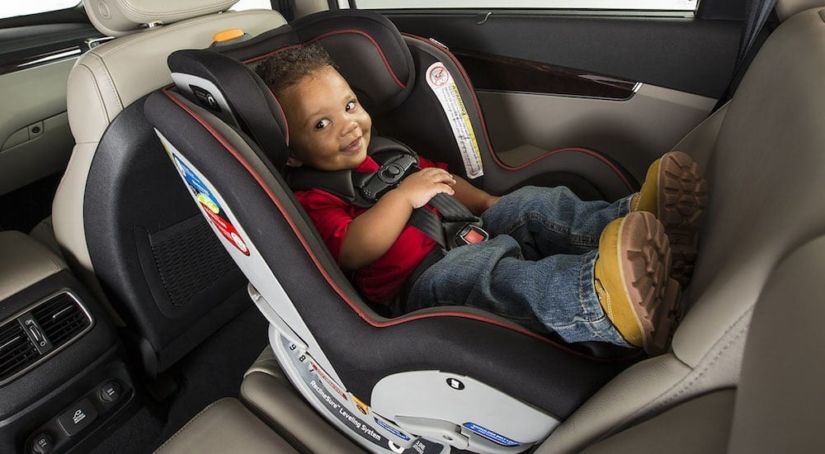As someone who recently had their first child, let me tell you the number of times I’ve heard “back when I had kids we [insert some action that’s considered terribly dangerous today] and look – everyone survived!” It’s constant. Ask any parent with children of any age and I guarantee you they’ve been told the same.
Of course it’s not a new thing. Well-meaning parents and grandparents have always tried to ease the anxiety of the next generation by telling them about all of the gambles and risks they took with their offspring – usually without even knowing they were putting their kids in harm’s way. Think about smoking… for a long time no one thought it was bad for children to be exposed to secondhand smoke. Now most parents wouldn’t dream of smoking around their children. Goes to show how information and times change.
Recently someone told me that I shouldn’t worry about the car seat so much since “back when we had kids, we didn’t have car seats! We just drove around holding the babies and look! Everyone survived!”
Now this got me thinking. Obviously, now we know not only is it extremely important to use a car seat and use it correctly – it’s illegal not to. But when did someone actually stop and realize that perhaps securing a child in a properly sized seat would be a little safer than just putting them on a passenger’s lap? And how did that move from being a thing that new parents were told was “overly cautious” to being a legally mandated automotive necessity? I decided to a do a little research into the rise of the car seat – a safety staple so ingratiated into the automotive industry that you’d be hard-pressed to find a car for sale not equipped for one.
Car Seats Were for Sanity, not for Safety
If you think that the first car seats were invented to stop little Timmy from being catapulted across the car in the event of a crash, well, you’re wrong. The first car seats were to save mom and dad from losing their minds as their kids crawled and cartwheeled all over the backseat. Basically, the first car was simply a means to restrain kids from getting in the way. So while there were some iterations of car seats dating back to the 1930s, they weren’t exactly designed with the protection of the child in mind.
The first car seats made for safety were designed in the 1960s, but it wasn’t until 1968 that Ford and General Motors started designing car seats to provide crash protection. The Infant Love Seat, created by General Motors, was the first rear-facing only restraint car seat on the market and it retailed for $13.10.
Car Seats: Lifesaving Laws, Lax Enforcement
While it may have taken a long time to get car seats on the market, it didn’t take long for the federal government to decide that it was probably a good idea to set some rules about children and car safety. In 1971, the National Highway Traffic Safety Administration said that not only did children have to be harnessed while in the car, but the harness (aka car seat) had to be locked in place via a seat belt. No more free-roaming for tots of the 1970s.
In 1979, Tennessee was the first state to enact a child restraint law and by 1985 every single state had passed a car seat law. However, according to Safe Ride 4 Kids, by 1987 only 80% of children were being restrained in car seats. Even now, 20 years later, the CDC reports these alarming statistics:
- In the United States, 663 children ages 12 years and younger died as occupants in motor vehicle crashes during 2015, and more than 121,350 were injured in 2014
- One CDC study found that, in one year, more than 618,000 children ages 0-12 rode in vehicles without the use of a child safety seat or booster seat or a seat belt at least some of the time.
- Of the children ages 12 years and younger who died in a crash in 2015 (for which restraint use was known), 35% were not buckled up.
Some people make the argument that cars are now safer than ever before thanks to the generous amounts of airbags and the impressive array of safety technology available. However, no amount of safety technology can help your child in the event of a crash like a car seat can.
Parents: We’re Trying Our Best, But Still Failing
One issue that often arises with the use of a car seat is that the installation is incorrect. In fact, 73% of car seats are incorrectly installed. Moreover, a recent study from the American Association of Pediatrics found that 95% of parents made a mistake when either installing their car seat or positioning their baby in the car seat. 95%. That means a mere 5% of American parents are actually using their car seats correctly.
Shocking right? Even with the LATCH anchor system now mandatory in all passenger cars, it’s still a challenge to actually install the car seat correctly. And of course, even if you get the car seat in perfectly, you still have to put your small, squirmy infant in and place the straps accordingly. It’s really no wonder that so many well-meaning parents make a mistake when it comes to using the car seat: it may seem foolproof, but it’s really anything but.
Leave it to the Pros
Of course, there are dozens of cheat sheets and resources online to help you learn how to install a car seat correctly and how to place the straps to best protect your little ones. However, if you really want to play it safe (and when it comes to car seats you absolutely should), do the wise thing and have your car seat installed and inspected by a car seat technician. Started in 1997 by the NHTSA, the Child Passenger Safety Technician program has trained more than 154,000 people on the correct use of car seats. Take advantage of their training and make sure your child is protected in their car seat.
After all, while times change and parenting “rules” might differ, if we’ve learned anything throughout the years it’s that there’s no room to compromise when it comes to car seat safety.



